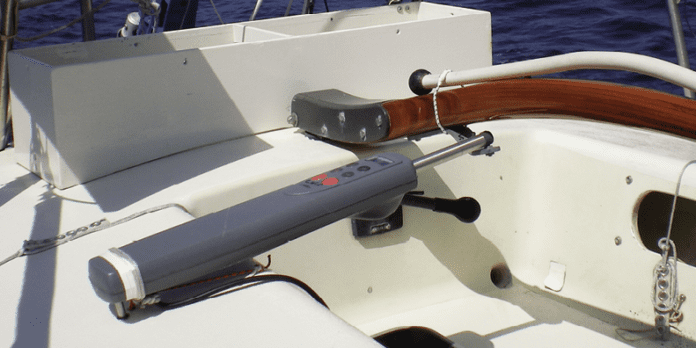In very light winds the tiller pilot will make corrections that are too small and the boat will not turn quickly enough to complete a tack. Even when sailing single handed, it will probably be better to operate the tiller manually. Once the wind reaches 5 knots you should be able to use the auto-tack function, but it may need some modifications. Below, we assume that you are singlehanding, otherwise crew would hand-steer through the tack.
• Point high with good speed.
• Put one turn on the windward winch and install the winch handle. Remove the winch handle from the leeward winch, and reduce the number of turns to the bare minimum for the conditions. Hold the tail of the sheet in your hand.
• Press +10 on the pilot once or twice. Wait about 5 seconds, and then push the auto-tack button. This will make the boat tack through 110-120 degrees, giving you more time to trim and avoid getting caught in irons. It makes the tack more reliable.
• Release the mainsheet a few inches when the boat is head to wind. This also reduces the tendency to go into irons by reducing the aft pressure from the mainsail. It is optional and is most beneficial in waves. Release more sheet in stronger winds.
• Release the jib just after it breaks and before reaching head to wind. Trim it in just as it is at the right angle to fill properly (release with control, taking off turns as needed—this varies with the boat and the wind). Trimming in at just the right moment will minimize grinding and help pull the bow through the turn. In lighter winds and smaller boats, grinding may even be eliminated, because the sail is brought in when there is practically no load on it. This should be your main focus during the tack.
• Finish trimming and adjust to best course. If the angles were correct, you will be sailing full-and-by and will need to head up 10-20 degrees as the sails are trimmed in. This is fine, because you will accelerate out of the tack better anyway. This is preferable to coming out of the tack right at your pointing angle, imperfectly trimmed, making leeway, and stuck going slow.
Jibing under autopilot is similar to tacking, but with different modifications. Below, we assume you are single-handed and not using a spinnaker.
• Make sure you are 125-135 degrees off the true wind. The auto-tack default setting is a 100-degree turn, so if you are at a different angle you will come out of the jibe either too high or too low.
• Center traveler and sheet in main. This will make things a lot simpler.
• If there is a jib outhaul, pull it out on the new side before jibing.
• Auto-tack. Again, focus on the jib, bringing it across at the same time as the wind.
• After the jib is across, ease the main and traveler. Be prepared to do this quickly if the wind is strong and your boat is inclined to round up. Keep the mainsheet and traveler tails handy, so that you can do this while trimming the jib if needed.
• If you have a reacher or asymmetrical, make the turn on manual (standby mode) instead. Pause at dead downwind and pull the sail across. Then finish the turn. You can do this with a large genoa as well. Limit this practice to light to moderate winds.
• Another singlehanded reacher and asymmetric jibing option is to furl them before jibing, and redeploy after you are settled on the new course. I often do this when it’s blowing hard.
Practical Sailor tech editor Drew Frye is the author of several books on sailing and regularly blogs at
www.sail-delmarva.com.







































